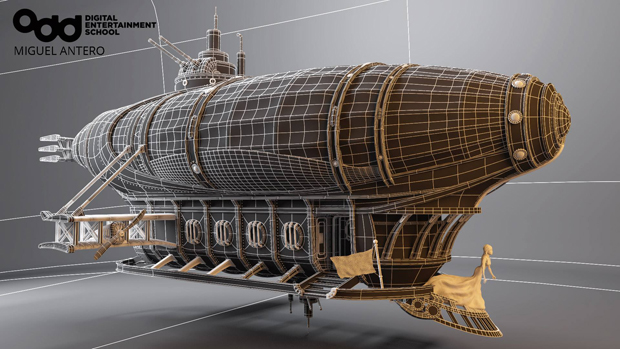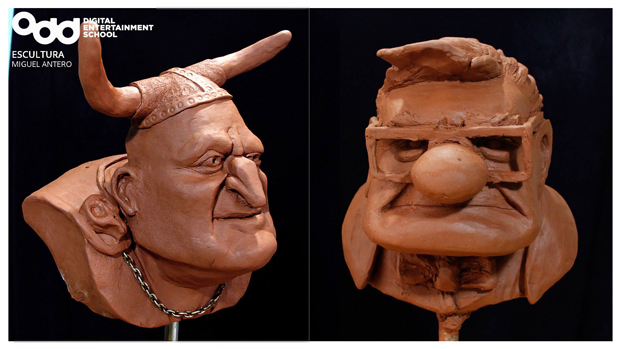
After Odd School placed 21st on our 2014 Top 100 International Animation Schools list, we reached out for an interview to learn more about their small but tremendously successful school in Lisbon, Portugal. We were so impressed that we asked them to stay in touch so that we could show our readers what their current students were working on. Their one year Advanced 3D Modelling and Texturing class just finished and we’re honored to be able to share the outstanding results from their course in our six part student interview series!
With translation help from their class’s instructor, David Dias, the fourth student we interviewed was Miguel Antero, and you can see his impressive 3D work from the Odd School class below.

Congratulations on finishing the Advanced 3D Modelling and Texturing class with so many excellent pieces of art! Tell our readers a little about yourself as a student and as an artist. What are your interests and your career goals?
Miguel Antero: First of all, thanks for this opportunity to talk about my final project. I'm 24 and before going to Odd School I took a college degree in Design, but I was a bit lost and didn't know exactly what I should do after it. At the same time I was taking my degree I searched some tutorials and tried to make some 3D models in my free time, but I never thought one day I would become a 3D artist since here in Portugal there are only a few 3D schools.
How and when did you realize you wanted to become a 3D artist?
Miguel Antero: Maybe when I was younger and played a lot of video games and wanted to know how they made them. Then I hear about mods (game modification where people make new characters, vehicles, etc.) and I wanted to make my own changes. Then I searched for some 3d programs and thankfully I found 3ds Max.

Some people are naturally good at art, but no one is born with 3D software skills. Your portfolio shows that you clearly learned a lot! What do you feel is your best 3D art skill? And what is your favorite part of creating 3D art?
Miguel Antero: My favorite part of creating 3D art is texturing. It's really nice when I spend some time trying to tweak a material and finally make it look right like what I initially imagined. The same happens with lighting but it is not so exciting. But my best skill is modeling hard surface and at the moment I'm trying to improve some sculpting techniques.
I’m a firm believer that perfect artists don’t exist, and we’re all constantly learning new skills and ideas. What was the hardest skill for you to understand and eventually excel at? How did Odd School help you strengthen your weakness?
Miguel Antero: Initially the problem was that feeling of not having a lot of trust of what I was doing. For example, modeling something and thinking if it was the best way to be modeled. But with the support of our instructors I became more confident. Before going to Odd School I had some idea how the render engine works, but definitely didn't know what those numbers really meant, like samples and interpolation that made my render time so long. Now I'm used to it, and my renders take less time.

What were most assignments like at Odd School? What was your favorite assignment?
Miguel Antero: Usually in class we would have specific assignments according to what we were learning at the time, the assignments usually didn't have a specific time to complete them, we would just see how it went depending on everyone’s difficulties, most of the time with the help of our instructor. The teachers would give us feedback while we were working just to see how we were doing. My favourite assignment was to model a fighter as an introduction to character modeling. In this exercise we learned how to create subsurface scattering, where we painted all the layers of the skin and then use the light to stand out the effect.
Tell us about your final project for the class. What were the challenges involved with completing it?
Miguel Antero: The biggest challenge was definitely time. Not that we had few, but a lot of it. That sounds awkward, but our final project started at the beginning of the year, and I didn't know how much time it would take to make everything, so in the middle of the year I was a bit confused if the project was on time or running late. Hopefully I finished it in time and did more than what initially thought. Another problem was the fact that we were learning and working for the project at the same time, resulting in making some models again in a different way.

What was a normal day of class like?
Miguel Antero: Our classes used to take 4 hours each in the morning and then 4 more hours to work on our projects by ourselves in the afternoon. During the 4 hours in morning we used to learn new techniques, tricks, and tips. Normally our teachers gave us some exercises after talking about the subject so we can apply what they taught. Students and teachers get along very well and have a close relationship.
David mentioned that the class also had workshops with Florian Degensicourt (Ubisoft Concept Artist), Manuel Virks (Crytek 3D Artist), and Vlad Costin (Character Artist for Guerrilla Games & Crytek). Can you tell us more about these workshops? What parts were the most helpful for you?
Miguel Antero: Those were one week workshops where we learned some new techniques. With Manuel Virks we learned how it works when dealing with video games. We modelled and texturized a rock and then exported it to Unreal Engine. We learned how to make things really low poly, and how to create normal maps and how it works. With Vlad Costin, he taught us how to use Marvelous Designer to create really nice cloths. Almost everything I learned with them I applied in my final project, so I really appreciated their workshops.

What software and plugins do you use the most? Tell us a little bit about your work process.
Miguel Antero: I use 3ds Max to model hard surface models, materials, lighting and rendering. I also use ZBrush for organic modeling and some polypainting, but I still prefer Mudbox as texturing resolution doesn't depend from mesh density. I also use Photoshop to creating some textures and post production.
What are your favorite resources for 3D art reference material?
Miguel Antero: Every day I visit CG Society and Art Station to check what other artists are doing and at the same time improving my creativity. For textures I use CG Textures and Arroway Textures.

What piece of advice did you learn from Odd School that you think every 3D art student around the world should hear?
Miguel Antero: One thing David was always saying was to look for references before modeling something. It really helps having references of what you want to do from different angles because in that way you will never get lost and never have to make up stuff. It also helps for texturing as you can see how the object reflects light, so you can understand how it works and have a more realistic material.
For all the artists reading who are inspired to follow in your footsteps, what would you tell them is the first thing they should study and master before doing everything else?
Miguel Antero: In my case since I took a Design degree I think it helped because I had some subjects like art history and economics that can change the way you look things around you. For example, sometimes I find myself looking for an old metal to see where it is more likely to have rust or how light pass through my window and bounces to the walls. Things that we see every day they, but we never thought about it and will of course improve our results.

What are some of the popular trends you’ve noticed in the 3D art industry in recent years? In what ways do you expect things to change in the next few years?
Miguel Antero: I think one of the most popular trends is to do more realtime renders since we can have an almost finished look just in seconds. Mixing this with motion capture was maybe one of the biggest jumps. Unfortunately it's not for everyone. I expect in a near future more user friendly 3D application, so more people can give a try and create their concepts, but I think it is kinda happening at the moment since there are some free programs out there.
Where do you see yourself in a year from now? And where can our readers follow you online?
Miguel Antero: At this moment I'm working on an advertising company in Lisbon. It is my first job and it is being a grateful experience since now I can really see how big projects are done. At the moment I've been there for two weeks and I learned a lot only by sharing experiences with coworkers. It's not my dream job, since I like having my own ideas and be creative, but I can use my spare time to work on my portfolio where I can be as creative as I want.
You can follow my work here on CG Society, Art Station, Behance, and LinkedIn.

Lastly, what other advice would you give to aspiring 3D artists?
Miguel Antero: If you really want to work in this industry, never give up! Sometimes it can be really frustrating, but at the end it's worth it. One advice I can tell you is to create a simple light setup during modeling process where you can simple render your scene just to check how things are going on with all that nice shadow instead of viewport shading, and at the same time it gives you a push to carry on.
Thanks for your time and your thoughts!
This is just one of our six part Odd School student interview series. We’ve interviewed hundreds of schools, studios, and students in the past, and we invite you to check out the other discussions in our Animation Career Review Interview Series archive.

